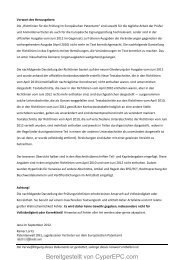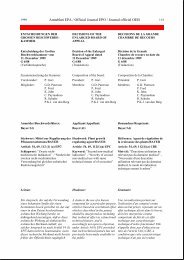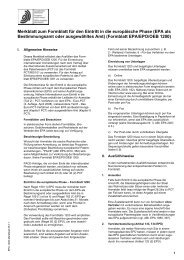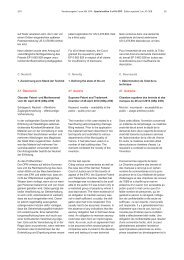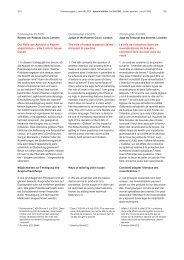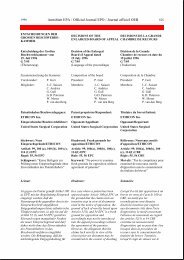110 <strong>Sonderausgabe</strong> 3 <strong>zum</strong> <strong>ABl</strong>. <strong>EPA</strong> Special edition 3 of OJ EPO Edition spéciale 3 du JO OEB <strong>2011</strong>schatz zu betrachten, der dem mit normalerKombinationsgabe ausgestattetenFachmann bzw. Fachteam für dieLösung der Aufgabe zur Verfügunggestanden hat; aber die Kombinationvon Einzelelementen aus dem Stand derTechnik findet ihre Grenze dort, wo siezu einer künstlichen Ex-post-Betrachtungin Kenntnis der beanspruchtenErfindung führen würde. Eine Kombinierungvon Entgegenhaltungen ist nurzulässig, wenn dafür Anregungen imStand der Technik vorhanden waren.Da die Vorinstanz die Anforderungen andie Fachperson nicht definiert hatte undauch sonst ihr methodisches Vorgehenin Bezug auf die erfinderische Tätigkeitnicht nachvollziehbar war, wurde derkantonale Entscheid aufgehoben unddie Sache zur neuen Beurteilung zurückgewiesen.Hier erwog das Bundesgericht,der in der Rechtsprechung derBeschwerdekammer des <strong>EPA</strong> maßgebendeAufgabe-Lösungs-Ansatz seizwar nicht die ausschließlich zulässigeMethode; unerlässlich seien jedoch Feststellungen<strong>zum</strong> Stand der Technik, <strong>zum</strong>Fachmann und <strong>zum</strong> (Nicht-)Naheliegender im Streitpatent offenbarten Lösung,da ansonsten das Ergebnis der Streitentscheidungnicht überprüfbar sei.combination of individual prior-artelements, i.e. where it would be anartificial ex post facto analysis in theknowledge of the claimed invention.Citations could be combined only if theprior art hinted at doing so.The Cantonal Court had not defined thecriteria for the skilled person, and itsapproach to inventive step was unclear.The Federal Court therefore set theimpugned decision of the Cantonal Courtaside and sent the case back for furtherprocessing, commenting that althoughthe problem-solution approach used bythe EPO boards of appeal was not theonly admissible method, contestabledecisions should include statements withregard to the prior art, the skilled personand whether or not the solution disclosedin the patent was obvious, becauseotherwise they could not be reviewed.revendiquée. Certes tous les enseignementsaccessibles au public et les documentscités peuvent être considéréscomme le bagage technique dont disposaient,pour la résolution du problème,l'homme du métier ou le groupe d'experts,ceux-ci ayant à cet égard unecapacité normale à combiner deséléments entre eux. Cependant, deséléments individuels provenant de l'étatde la technique ne peuvent plus êtrecombinés dès lors qu'ils conduisent àune appréciation rétroactive artificielle àla lumière de l'invention revendiquée.Des documents ne peuvent être combinésentre eux que si l'état de la techniquecontient des suggestions en cesens.Etant donné que l'instance ayant rendula décision attaquée n'avait pas défini lesexigences auxquelles l'homme du métierdevait satisfaire, et que, par ailleurs, ils'était avéré impossible de comprendrela méthode d'examen de l'activité inventive,la décision du Tribunal cantonal aété annulée et l'affaire renvoyée pournouveau jugement. A ce sujet, le Tribunalfédéral suisse a considéré que l'approcheproblème-solution suivie par lajurisprudence des chambres de recoursde l'OEB n'est certes pas la seuleméthode admissible, mais qu'en revanche,il est nécessaire de déterminer l'étatde la technique, les exigences relativesà l'homme du métier et les faits quiétablissent le caractère évident (ou nonévident) de la solution exposée dansle brevet en cause, faute de quoi unerévision des conclusions de la décisionattaquée est impossible.DE DeutschlandBundesgerichtshof vom 7. März 2006(X ZR 213/01) – VorausbezahlteTelefongesprächeSchlagwort: erfinderische Tätigkeit –FachmannDas Streitpatent betraf ein Verfahren<strong>zum</strong> Verarbeiten von im Voraus bezahltenTelefonanrufen. Die Streitpatentschriftbezog sich dabei auf das in einerälteren US-Patentschrift beschriebeneVerfahren und System zur Verarbeitungim Voraus bezahlter Telefonanrufe, welchessich auf spezielle, zertifizierbareCodezahlen stützte. Diese wurden denDE GermanyFederal Court of Justice of7 March 2006 (X ZR 213/01) –Prepaid phone callsKeyword: inventive step – skilledpersonThe patent concerned a method ofprocessing prepaid phone calls. Thespecification referred to a method andsystem of such processing described inan earlier US patent specification whichwas based on special certifiable codesallocated to the caller on purchase ofcredits. The credits were stored inspecial central computers, allowing callsDE AllemagneCour fédérale de justice du7 mars 2006 (X ZR 213/01) –Appels téléphoniques prépayésMot-clé : activité inventive – homme dumétierLe brevet contesté portait sur un procédéde traitement des appels téléphoniquesprépayés. Le fascicule du brevet encause faisait référence au procédé etsystème de traitement des appels téléphoniquesprépayés, décrit dans unbrevet américain plus ancien, qui reposaitsur des numéros de codes spéciauxpouvant être certifiés. Ces codes étaient
<strong>2011</strong> <strong>Sonderausgabe</strong> 3 <strong>zum</strong> <strong>ABl</strong>. <strong>EPA</strong> Special edition 3 of OJ EPO Edition spéciale 3 du JO OEB 111Anrufern gegen Erwerb eines Guthabenszugeteilt. Die Guthaben wurden imComputer spezieller zentraler Stationengespeichert, sodass von jedem beliebigenprivaten Telefon angerufen werdenkonnte. An diesem Verfahren kritisiertedie Streitpatentschrift als Nachteil, dassderjenige, der interessiert sei, diesesVerfahren zu nutzen, eine ganze Reihevorbereitender Schritte durchlaufenmüsste – meistens über Kreditkartenunternehmen–, um eine entsprechendeBerechtigung zur Nutzung des Systemszu erhalten. Die Streitpatentschriftbezeichnete es somit als Aufgabeder Erfindung, die Nachteile der öffentlichenMünz- und Magnetkartentelefonanschlüssezu vermeiden und zugleichjede vorherige Verbindung mit Telefonkarten-und/oder Kreditkartenunternehmenüberflüssig zu machen. Das BPatGhatte in der Vorinstanz das Streitpatentfür nichtig erklärt.Der BGH hielt das Patent für neu underfinderisch. Ob sich der Gegenstandeiner Erfindung für den Fachmann innaheliegender Weise aus dem Stand derTechnik ergebe, sei eine Rechtsfrage,die mittels wertender Würdigung der tatsächlichenUmstände zu beurteilen sei,die – unmittelbar oder mittelbar – geeignetseien, etwas über die Voraussetzungenfür das Auffinden der erfindungsgemäßenLösung auszusagen.Der angesprochene Fachmann sei nichtmit einer tatsächlich existierenden Persongleichzusetzen. Eine dem Gebot derRechtssicherheit genügende einheitlicheBeurteilung einer Erfindung wäre auf derGrundlage individueller Kenntnisse undFähigkeiten auch gar nicht möglich.Fachmännisches Denken, Erkennen undVorstellen werde deshalb bemüht, ummit dem auf dem betreffenden Gebietder Technik üblichen Fachwissen sowieden durchschnittlichen Kenntnissen,Erfahrungen und Fähigkeiten der dorttätigen Fachleute und dem hierdurchgeprägten Verständnis vom Inhalt einertechnischen Lehre eine verlässlicheEntscheidungsgrundlage zu gewinnen.to be made from any private telephone.The specification of the patent at issuecriticised as a drawback of that systemthe fact that those interested in using ithad to go through a series of preparatorysteps – usually via credit-card companies– to obtain user rights. According tothe patent, the object of the inventionwas therefore to overcome the drawbacksof coin- and card-operated publicpayphones, whilst at the same timeobviating the need first to contact phoneand/or credit-card companies. In theFederal Patents Court the patent hadbeen revoked.The Federal Court of Justice, however,held that the patent was novel and inventive.Whether the subject-matter of aninvention was obvious to the skilledperson in the light of the prior art was aquestion of law to be answered by wayof a critical assessment of the facts apt –be it directly or indirectly – to provideinformation on the prerequisites forarriving at the solution according to theinvention.The skilled person in question could notbe equated with any real person. Indeed,inventions could not be assessed in auniform manner so as to meet therequirements of legal certainty on thebasis of an individual's knowledge andskills. Therefore, the courts used thethought processes, understanding andimagination of the skilled person toprovide a reliable basis for reachingdecisions in the light of the specialistknowledge usual in the relevant technicalfield, the average knowledge, experienceand skills of experts in that field and theresulting understanding of the content ofa technical teaching.attribués aux utilisateurs moyennantl'achat d'un crédit. Les montants decrédit étaient mémorisés dans l'ordinateurde centres spéciaux, ce qui permettaitd'effectuer des appels à partir den'importe quel téléphone privé usuel.Le fascicule de brevet critiquait, commeinconvénient de ce procédé, que celuiqui s'y intéressait en tant qu'utilisateurdevait parcourir toute une série d'étapespréparatoires – généralement auprèsd'organismes de cartes de crédit – afind'obtenir une légitimation pour l'utilisationdu système. Le fascicule de brevet désignaitdonc comme problème à la basede l'invention qu'il s'agissait d'éviter lesinconvénients des installations téléphoniquespubliques à monnaie ou à cartemagnétique et en même temps derendre superflu toute communicationpréalable avec l'organisme de cartesde téléphone ou de cartes de crédit.Au cours de l'instance précédente, leTribunal fédéral des brevets avaitprononcé la nullité du brevet.La Cour fédérale de justice, elle, a considéréle brevet comme nouveau et inventif.La question de savoir si l'objet d'uneinvention découle de manière évidentede l'état de la technique est une questionde droit qui nécessite, pour y répondre,de porter un jugement sur les circonstancesconcrètes susceptibles de révéler –directement ou indirectement – quelquechose sur les conditions pour trouver lasolution selon l'invention.Il ne faut pas confondre l'homme dumétier, dont il est ici question, avec unepersonne existant réellement. Parailleurs, il serait tout à fait impossibled'apprécier les inventions de façonuniforme, en conformité avec l'exigencede sécurité juridique, sur la base deconnaissances et d'aptitudes individuelles.On fait donc appel aux modes depensée de l'homme du métier, à sesconnaissances et à son imaginationpour acquérir une base de décisionfiable en s'appuyant sur les connaissancescourantes d'un expert du domainetechnique concerné, ainsi que sur lesconnaissances, expériences et aptitudesmoyennes des praticiens dans cedomaine, qui conditionnent leur compréhensiond'un enseignement technique.



